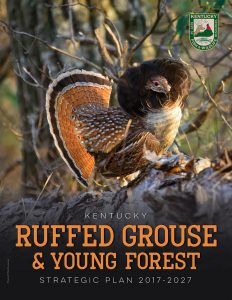 A newly published plan developed by the Kentucky Department of Fish and Wildlife Resources offers a long-range strategy to help ruffed grouse populations rebound in eastern Kentucky after years of decline.
A newly published plan developed by the Kentucky Department of Fish and Wildlife Resources offers a long-range strategy to help ruffed grouse populations rebound in eastern Kentucky after years of decline.
The Ruffed Grouse and Young Forest Strategic Plan looks 10 years out and its success hinges on an array of partners working together to create the young forest habitat on which grouse and other woodland species can thrive.
“This will be an ambitious effort, aimed at turning the tide for the ruffed grouse,” Kentucky Fish and Wildlife Commissioner Gregory K. Johnson said. “There is no doubt this is a challenge that can become a real opportunity. We are accepting this challenge with every intent to be successful. We will need your help – our sportsmen, our partners, our colleges and universities, and our forest products industry. Only together can we be successful restoring this magnificent game bird to our landscape.”
The strategic plan, more than two years in the making, incorporates input received from the public and other stakeholders. It is available on Kentucky Fish and Wildlife’s website at fw.ky.gov.
Grouse are upland birds that spend much of their time on the ground. Prized by hunters for the challenge it presents, and renowned for its explosive take-offs when flushed, the species needs a mosaic of habitat.
Hunters in Kentucky enjoyed decades of high grouse densities last century; a direct result of the timber harvest, farm abandonment and surface mine reclamation that took place in preceding years.
Much of eastern Kentucky’s forests have matured since then into more open stands that do not provide the dense protective cover or food sources grouse need to survive and reproduce. At the same time, in many forests a lack of management has favored red maples in the understory. Maples do not produce the protein-rich nuts like the acorns that mature oak trees do. The hard mast helps grouse survive winter in better condition, leading to better reproduction in spring.
“The ideal recipe for grouse is a landscape that is at least 75 percent forested, at least 5,000 to 10,000 acres, and at least 20 to 30 percent young forests. The bigger and more diverse in terms of forest stand ages and species diversity, the better,” said Zak Danks, ruffed grouse and wild turkey program coordinator with Kentucky Fish and Wildlife. “A large clear-cut that is 10 years old is prime for grouse, but only for another 10-15 years. They also use older forest for nesting and foraging. You need that mix of young and old forest together. Patches of cutting don’t have to be that big – 20 to 40 acres is ideal – but you need a lot of those patches clustered within an area and across the surrounding landscape.”
The strategic plan covers the next 10 years and lays the groundwork for success far beyond that timeframe.
“The department is committed to working on grouse,” Danks said. “Over the next 10 years, we need to take a targeted approach for grouse. The objectives outlined in this plan will not be easy to accomplish, but provide the only real way to get grouse back.”
A collaborative, science-guided approach to habitat management is at the heart of the new strategic plan.
It calls for Kentucky Fish and Wildlife working with federal, state and local agencies, as well as corporations and private landowners to manage forests on focus areas by creating habitat beneficial to grouse and other wildlife. Focus areas may include wildlife management areas, state forests, the Daniel Boone National forest and private lands.
A successful outcome will require a commitment to sustainable forest management. This includes commercial timber harvests and noncommercial habitat treatments designed to stimulate plant growth for grouse broods, high stem densities for year-round cover and oak regeneration for the future forests, while maintaining select mature, acorn-producing trees to help boost oak stands in the forest. Public outreach to promote the importance of young forest habitat for woodland species will be key.
“In the grouse woods, a hunter often gets only a fleeting glimpse of his flushing quarry, and shots are often taken on faith,” Danks said. “We must embrace the challenge of grouse restoration now, and on behalf of grouse, blue-winged warblers, oaks and the suite of other species that cannot lobby for their own existence.”
 Weather
Weather Traffic
Traffic @LouisvilleDispatch
@LouisvilleDispatch @LouisvilleDisp
@LouisvilleDisp Subscribe
Subscribe
Leave a Reply